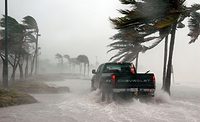2020 Atlantic Hurricane Season takes top spot for busiest on record

Pictured: Hurricane Iota becomes 2020’s strongest hurricane, threating Central America. Courtesy of NOAA
With less than a month remaining in the Atlantic hurricane season, the formation of Subtropical Storm Theta on November 10 and Hurricane Iota on the morning of November 16 made the 2020 season the most active on record.
Iota is the 30th named storm, the 13th hurricane, the 6th major hurricane (Category-3 +), and the first Category-5 storm of the record-breaking 2020 Atlantic hurricane season. It is also the latest-forming Category-5 hurricane on record. Additionally, 2020 is the 5th consecutive season where at least one Category-5 hurricane formed in the Atlantic basin, and the first time since 1932 where a Category-5 storm formed in November.

According to NOAA, Theta — the 29th named storm of the Atlantic season — broke the record for the highest number of tropical/subtropical storms in a single year. The previous record of 28 storms was set in 2005. Official records date to 1851.
“After the historic Atlantic hurricane season of 2005, it's remarkable to have another season during my career that would reach this extreme level of activity,” said Louis W. Uccellini, Ph.D., director of NOAA’s National Weather Service. “NOAA’s sustained investment in computer forecast models, technology, observing systems and our skilled workforce have paid off over the last 15 years, with exponentially improved hurricane forecasts.”

Uccellini explained that, the National Weather Service provides the advanced lead time decision makers need to evacuate vulnerable areas and stage resources ahead of landfalling storms and the impacts of strong winds, storm surge, and heavy rainfall. “We continue to evolve to meet society’s growing needs for more weather information and better forecasts increasingly used to ensure communities are ready, responsive and resilient in the face of oncoming storms,” he said.
The 2020 season began early when Arthur formed on May 16. The extremely active season quickly went through the pre-determined list of 21 names, ending with Wilfred on September 18. Then for only the second time in history, the Greek alphabet was used for the remainder of the season, with Alpha forming the same day.
The Atlantic hurricane season officially ends on November 30, but additional storms could develop beyond that date. Forecasters at NOAA’s National Hurricane Center continuously monitor the tropics for storm development and activity. Weather Service forecasters at NOAA's Climate Prediction Center issued an outlook in May for an above-average hurricane season and later upgraded that outlook to a rare, extremely-active season in August, ahead of the season's peak in the fall.
Looking for a reprint of this article?
From high-res PDFs to custom plaques, order your copy today!




